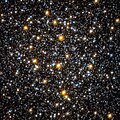File:NGC 6362 globular cluster HST.jpg

原始檔案 (3,061 × 3,061 像素,檔案大小:6.78 MB,MIME 類型:image/jpeg)
摘要
| 描述NGC 6362 globular cluster HST.jpg |
Polski: Gromada kulista NGC 6362. Zdjęcie wykonane przez Teleskop Hubble'a. English: NGC 6362 - An unexpected population of young-looking stars
The NASA/ESA Hubble Space Telescope offers an impressive view of the centre of globular cluster NGC 6362. The image of this spherical collection of stars takes a deeper look at the core of the globular cluster, which contains a high concentration of stars with different colours. Tightly bound by gravity, globular clusters are composed of old stars, which, at around 10 billion years old, are much older than the Sun. These clusters are fairly common, with more than 150 currently known in our galaxy, the Milky Way, and more which have been spotted in other galaxies. Globular clusters are among the oldest structures in the Universe that are accessible to direct observational investigation, making them living fossils from the early years of the cosmos. Astronomers infer important properties of globular clusters by looking at the light from their constituent stars. For many years, they were regarded as ideal laboratories for testing the standard stellar evolution theory. Among other things, this theory suggests that most of the stars within a globular cluster should be of a similar age. Recently, however, high precision measurements performed in numerous globular clusters, primarily with the Hubble Space Telescope, has led some to question this widely accepted theory. In particular, certain stars appear younger and bluer than their companions, and they have been dubbed blue stragglers. NGC 6362 contains many of these stars. Since they are usually found in the core regions of clusters, where the concentration of stars is large, the most likely explanation for this unexpected population of objects seems to be that they could be either the result of stellar collisions or transfer of material between stars in binary systems. This influx of new material would heat up the star and make it appear younger than its neighbours. NGC 6362 is located about 25 000 light-years from Earth in the constellation of Ara (The Altar). British astronomer James Dunlop first observed this globular cluster on 30 June 1826. This image was created combining ultraviolet, visual and infrared images taken with the Wide Field Channel of the Advanced Camera for Surveys and the Wide Field Camera 3. An image image of NGC 6362 taken by the MPG/ESO 2.2-metre telescope will be published by the European Southern Observatory on Wednesday. See it on www.eso.org from 12:00 on 31 October. Credit: ESA/Hubble & NASA About the Image Id: potw1244a Type: Observation Release date: 29 October 2012, 10:00 Size: 3061 x 3061 px About the Object Name: NGC 6362 Type: • Milky Way : Star : Grouping : Cluster : Globular Distance: 25000 light years Colours & filters Band Wavelength Telescope Ultraviolet U 336 nm Hubble Space Telescope WFC3 Optical R 625 nm Hubble Space Telescope ACS Infrared I 814 nm Hubble Space Telescope ACS. |
| 日期 | |
| 來源 | http://www.spacetelescope.org/images/potw1244a/ |
| 作者 | ESA/Hubble & NASA |
| 授權許可 (重用此檔案) |
http://www.spacetelescope.org/copyright/ |
| 其他版本 |
 |
授權條款
- 您可以自由:
- 分享 – 複製、發佈和傳播本作品
- 重新修改 – 創作演繹作品
- 惟需遵照下列條件:
- 姓名標示 – 您必須指名出正確的製作者,和提供授權條款的連結,以及表示是否有對內容上做出變更。您可以用任何合理的方式來行動,但不得以任何方式表明授權條款是對您許可或是由您所使用。
說明
在此檔案描寫的項目
描繪內容
29 10 2012
檔案歷史
點選日期/時間以檢視該時間的檔案版本。
| 日期/時間 | 縮圖 | 尺寸 | 用戶 | 備註 | |
|---|---|---|---|---|---|
| 目前 | 2012年11月4日 (日) 14:36 |  | 3,061 × 3,061(6.78 MB) | Fabian RRRR | higher resolution: source (direct link) http://www.spacetelescope.org/images/potw1244a/ |
| 2012年11月3日 (六) 12:17 |  | 1,280 × 1,280(715 KB) | Winiar | User created page with UploadWizard |
檔案用途
下列頁面有用到此檔案:
全域檔案使用狀況
以下其他 wiki 使用了這個檔案:
- el.wikipedia.org 的使用狀況
- en.wikipedia.org 的使用狀況
- fr.wikipedia.org 的使用狀況
- ht.wikipedia.org 的使用狀況
- nl.wikipedia.org 的使用狀況
- pl.wikipedia.org 的使用狀況
詮釋資料
此檔案中包含擴展的資訊。這些資訊可能是由數位相機或掃描器在建立時或數位化過程中所加入。
如果此檔案的來源檔案已被修改,一些資訊在修改後的檔案中將不能完全反映出來。
| 影像標題 |
|
|---|---|
| 線上版權聲明 | |
| 來源 | ESA/Hubble |
| 製作/提供者 | ESA/Hubble & NASA |
| 使用條款 |
|
| 簡稱 |
|
| 資料產生的日期時間 | 2012年10月29日 (一) 10:00 |
| 版權狀態 | 版權狀態不明 |
| 關鍵字 | NGC 6362 |
| 聯絡資訊 |
http://www.spacetelescope.org/ Karl-Schwarzschild-Strasse 2 Garching bei München, , D-85748 Germany |

